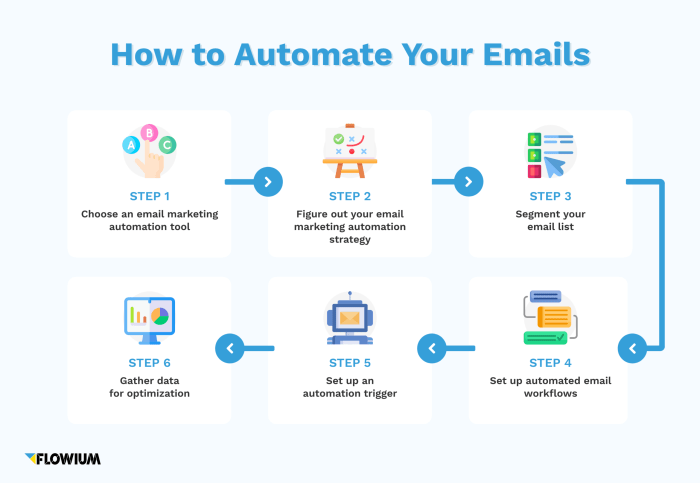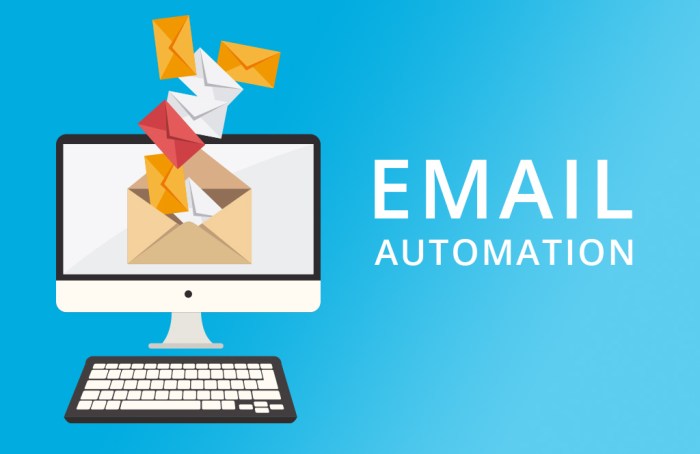Using Email Marketing Automation dives into the world of streamlining your campaigns with cutting-edge technology. From setting up to analyzing success, this guide has got you covered.
Overview of Email Marketing Automation: Using Email Marketing Automation
Email marketing automation is the use of software to automate email marketing actions, such as sending personalized emails to leads or customers based on specific triggers or schedules. It works by setting up predefined rules and workflows that automatically send emails to subscribers without the need for manual intervention.
Benefits of Email Marketing Automation
- Increased efficiency: Automation saves time by sending targeted emails to the right audience at the right time.
- Improved personalization: Automation allows for personalized content based on user behavior, leading to higher engagement.
- Better lead nurturing: Automated workflows can guide leads through the sales funnel, increasing conversion rates.
- Enhanced analytics: Automation provides valuable data on email performance, allowing for optimization and improvement.
Examples of Successful Email Marketing Automation Campaigns
Amazon’s personalized product recommendations based on previous purchases.
Spotify’s emails suggesting new music based on user listening habits.
Netflix’s reminder emails for users to continue watching a show they left unfinished.
Setting Up Email Marketing Automation
To set up email marketing automation effectively, follow these steps and tips:
Essential Tools and Software
- Choose a reliable email marketing automation platform like Mailchimp, Constant Contact, or HubSpot.
- Ensure the software integrates well with your CRM system to track customer interactions.
- Use tools for creating visually appealing email templates and personalized content.
- Implement analytics tools to track email performance and customer engagement.
Segmenting Email Lists for Targeted Automation
- Divide your email list based on demographics, purchasing behavior, and engagement levels.
- Create segments for new subscribers, loyal customers, inactive users, or specific product interests.
- Personalize email content for each segment to increase relevance and engagement.
- Automate email campaigns to send targeted messages at the right time to each segment.
Creating Automated Email Campaigns

Creating engaging and personalized email templates is crucial for successful email marketing automation. When designing these templates, it’s important to consider the target audience, brand identity, and the desired action you want recipients to take. By personalizing the content, subject line, and visuals, you can increase engagement and conversion rates.
Importance of A/B Testing
A/B testing plays a vital role in automated email campaigns as it helps in determining which elements of the email are resonating with the audience and driving the desired outcomes. By testing different subject lines, content variations, visuals, and call-to-action buttons, you can optimize your emails for better performance. This data-driven approach allows you to make informed decisions and continuously improve your email campaigns.
- Test different subject lines to see which ones result in higher open rates.
- Experiment with different email content to identify what resonates best with your audience.
- Try out various visuals and call-to-action buttons to see which ones drive more clicks and conversions.
Best Practices for Timing and Frequency
Timing and frequency are key factors to consider when setting up automated email campaigns. Sending emails at the right time can significantly impact open rates and engagement. It’s essential to understand your audience’s behavior and preferences to determine the best times to send emails. Additionally, finding the right balance in the frequency of emails is crucial to avoid overwhelming subscribers.
- Consider sending emails during peak hours when your audience is most likely to check their inbox.
- Avoid bombarding subscribers with too many emails in a short period to prevent fatigue and unsubscribes.
- Use data analytics to track the performance of your emails and adjust the timing and frequency based on the results.
Measuring Success and Optimization

When it comes to email marketing automation, measuring success and optimizing campaigns are crucial steps in ensuring effectiveness and achieving desired outcomes.
Key Metrics to Track, Using Email Marketing Automation
Tracking key metrics allows you to evaluate the performance of your automated email campaigns and make data-driven decisions for optimization.
- Open Rate: The percentage of recipients who open your emails.
- Click-Through Rate (CTR): The percentage of recipients who click on links in your emails.
- Conversion Rate: The percentage of recipients who complete a desired action, such as making a purchase.
- Bounce Rate: The percentage of emails that were not successfully delivered to recipients.
Analyzing Data and Optimization Strategies
Once you have collected data from the key metrics, it’s important to analyze the information and optimize your automated campaigns accordingly.
- Segmentation: Use data to segment your audience and send targeted, personalized emails for better engagement.
- A/B Testing: Experiment with different subject lines, content, and send times to determine what resonates best with your audience.
- Automation Workflow Review: Regularly review and refine your automation workflows to ensure they are efficient and effective.
Using Insights for Future Automation Efforts
By leveraging insights from analytics, you can continuously improve your email marketing automation efforts for better results.
- Identify Trends: Look for patterns in data to understand what works well and what can be improved in your campaigns.
- Iterative Optimization: Implement changes based on data analysis and continue to refine your strategies over time.
- Feedback Loop: Encourage feedback from recipients and use it to make informed decisions for future automation efforts.